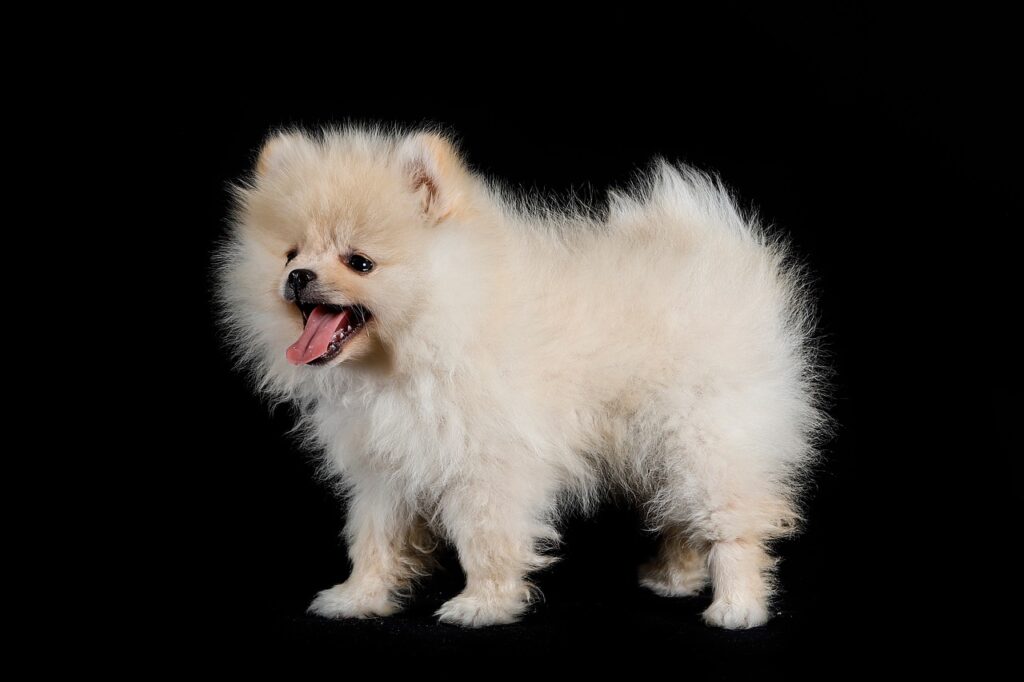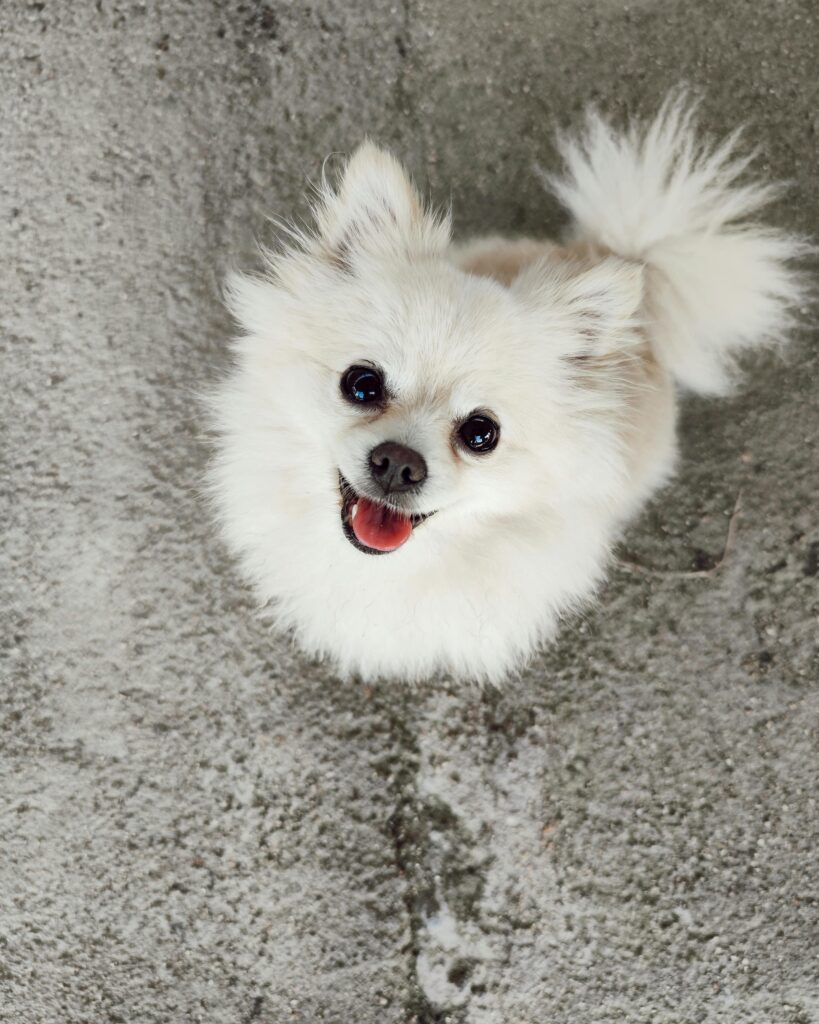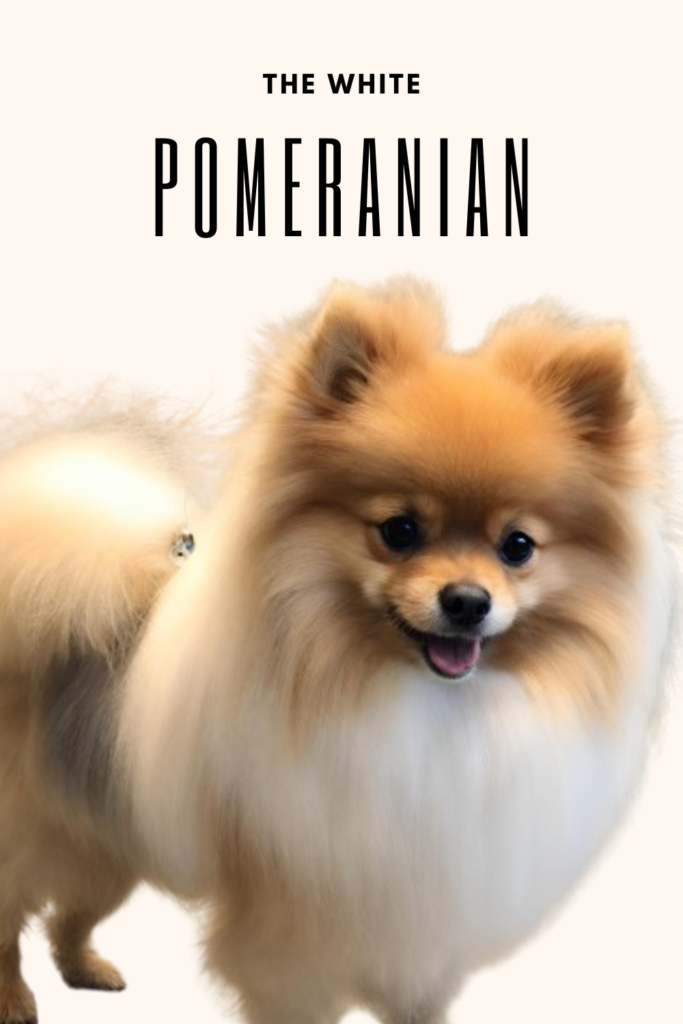Introduction
Welcome to the comprehensive owner’s guide and top facts about the charming White Pomeranian. Whether you’re a proud White Pomeranian parent or considering bringing one into your family, this guide will provide valuable insights into the breed’s history, characteristics, daily life, and more.

History Of The White Pomeranian
Breed Origin
Uncover the fascinating history of the White Pomeranian, tracing its roots and evolution. Explore how this breed, originally larger and of different colors, has transformed into the beloved pint-sized companion we know today.
The history of the white Pomeranian is intertwined with the broader history of the Pomeranian breed itself. Pomeranians are descendants of larger sled and herding dogs from the Arctic regions, particularly in the Pomerania region, which is now part of Germany and Poland. These larger dogs were used for various tasks, including herding livestock and pulling sleds.
Through selective breeding, particularly in the 18th and 19th centuries, the size of the Pomeranian was gradually reduced, and its appearance was refined to become the smaller, toy-sized breed we recognize today. White Pomeranians, along with other coat colors, emerged as part of this breeding process.
White Pomeranians are known for their beautiful, pristine coats that can range from pure white to cream or ivory. Like other coat colors of Pomeranians, the white coat is a result of genetic inheritance and selective breeding.
Over time, Pomeranians, including those with white coats, gained popularity as companion animals among royalty and aristocracy in Europe. Queen Victoria of England was particularly fond of the breed, which further popularized them among the elite and contributed to their recognition worldwide.
Today, white Pomeranians remain a sought-after variation of the breed, known for their fluffy coats, lively personalities, and compact size. They are cherished as beloved companions and continue to be popular in the world of dog lovers and enthusiasts.

Characteristics Of The White Pomeranian
Appearance:
The White Pomeranian is a small, compact dog breed with a distinctive appearance. They typically weigh between 3 to 7 pounds and stand around 6 to 7 inches tall at the shoulder. Despite their small size, they possess a sturdy build with a foxy face, erect ears, and a plumed tail that curls over their back. Their expressive eyes, often dark and almond-shaped, contribute to their charming and alert expression.
Coat:
The hallmark of the White Pomeranian is its luxurious double coat. The outer coat is long, straight, and harsh in texture, while the undercoat is soft, dense, and fluffy. Regular grooming is essential to maintain the coat’s pristine appearance and prevent matting and tangling. White Pomeranians may require more frequent grooming to keep their coat bright and clean compared to other coat colors.
Color:
White Pomeranians exhibit various shades of white, ranging from pure snow-white to creamy hues. The color of their coat is influenced by genetics and breeding. While some White Pomeranians may have a solid white coat, others may display slight markings or shading, particularly around the ears or paws.
Temperament:
White Pomeranians are renowned for their spirited and affectionate temperament. They are intelligent, curious, and lively dogs that thrive on attention and companionship. Despite their small size, they are often confident and bold, making them excellent watchdogs. White Pomeranians are known for forming strong bonds with their families and can be quite playful and outgoing with proper socialization and training.
Lifespan:
The typical lifespan of a White Pomeranian ranges from 12 to 16 years, though some individuals may live even longer with proper care and attention to their health needs. Providing a nutritious diet, regular exercise, routine veterinary care, and maintaining good dental hygiene can contribute to a long and healthy life for a White Pomeranian. Additionally, preventing obesity and managing potential health issues, such as dental problems and joint issues, can help ensure their well-being throughout their lifespan.
Known Health Issues
Navigate through potential health issues that White Pomeranian owners should be aware of. From dental care to genetic predispositions, learn how to keep your furry friend in optimal health.
Pomeranians, like all dog breeds, are prone to certain health issues. While not all Pomeranians will experience these problems, it’s essential for owners to be aware of potential health concerns. Some common health issues that Pomeranians may face include:
- Luxating Patella: This condition involves the dislocation of the kneecap and can cause lameness or difficulty in walking. Luxating patella is relatively common in small breeds like Pomeranians.
- Tracheal Collapse: Due to their small size and delicate trachea, Pomeranians can be prone to tracheal collapse, a condition where the cartilage in the trachea weakens, leading to breathing difficulties, coughing, and gagging.
- Dental Problems: Pomeranians are susceptible to dental issues such as tooth decay, gum disease, and early tooth loss. Regular dental care, including brushing their teeth and providing dental treats or toys, is crucial for maintaining their oral health.
- Hypoglycemia: Pomeranian puppies, in particular, are at risk of hypoglycemia, a condition characterized by low blood sugar levels. This can occur due to their small size and high metabolism. It’s essential to monitor their eating habits and provide frequent, small meals to prevent hypoglycemic episodes.
- Collapsed Trachea: Similar to tracheal collapse, this condition involves the weakening of the tracheal rings, leading to coughing, wheezing, and difficulty breathing, especially during exercise or excitement.
- Allergies: Pomeranians may develop allergies to various environmental triggers such as pollen, dust, or certain foods. Allergies can manifest as skin irritation, itching, redness, or ear infections.
- Eye Problems: Pomeranians are prone to various eye issues, including cataracts, progressive retinal atrophy (PRA), and dry eye syndrome (keratoconjunctivitis sicca). Regular eye examinations by a veterinarian can help detect and manage these conditions early.
- Heart Problems: Some Pomeranians may develop heart conditions such as mitral valve disease (MVD), which affects the heart valves’ function and can lead to heart failure if left untreated.
Regular veterinary check-ups, proper nutrition, regular exercise, and maintaining a healthy weight can help reduce the risk of these health issues in Pomeranians. Early detection and treatment of any potential health concerns are crucial for ensuring a long, happy, and healthy life for your Pomeranian companion.
Daily Life
Food and Diet:
White Pomeranians require a balanced diet rich in nutrients to support their health and vitality. Look for high-quality dog food brands that offer small breed formulas tailored to their needs. Opt for options that include real meat as the primary ingredient, along with wholesome grains and vegetables. Monitor their portion sizes to prevent overfeeding and obesity, which can be common issues in small breeds.
Best Dog Food for the White Pomeranian:
AvoDerm Natural Small Breed Dry Dog Food is an excellent choice for White Pomeranians. It contains premium ingredients such as real chicken or lamb, avocado oil, and a blend of vitamins and minerals to support their overall health. The small kibble size is perfect for their tiny mouths, and the formula provides essential nutrients for their coat, skin, and immune system.
Exercise:
Despite their small size, White Pomeranians have moderate exercise needs. Daily walks, interactive play sessions, and engaging toys can help keep them physically and mentally stimulated. Indoor activities such as fetch or puzzle toys can be particularly enjoyable for them, especially during inclement weather.
Family Compatibility:
White Pomeranians are well-suited for families of all sizes, including those with children and other pets, given proper socialization and supervision. They thrive on attention and companionship and enjoy being part of the family activities. However, due to their small size, they may be more susceptible to accidental injury, so interactions with young children should be supervised.
Training:
White Pomeranians are intelligent and eager to please, making them relatively easy to train. Use positive reinforcement techniques such as praise, treats, and consistency to teach them basic commands and good manners. Start training early and be patient and persistent, as consistency is key to their success.
Socializing:
Early and consistent socialization is essential for White Pomeranians to develop into well-adjusted and confident dogs. Expose them to various environments, people, and other animals from a young age to help prevent shyness or fearfulness. Positive experiences during socialization can shape their behavior and outlook on the world around them.
Grooming:
Regular grooming is crucial for maintaining the White Pomeranian’s pristine coat. Brush their coat at least a few times a week to prevent matting and tangling, paying extra attention to areas prone to knots such as behind the ears and under the legs. Bathe them as needed using a gentle dog shampoo formulated for sensitive skin, and ensure thorough drying to prevent skin irritation. Special care should be taken to keep their white fur bright and clean, avoiding staining from dirt or tear stains around the eyes. Regular dental care, nail trimming, and ear cleaning are also essential parts of their grooming routine.
White Pomeranian FAQ’s
Here are some frequently asked questions (FAQs) about White Pomeranians:
- Are White Pomeranians hypoallergenic?
No, Pomeranians, including White Pomeranians, are not considered hypoallergenic. While they may shed less than some other breeds, they still produce dander and saliva, which can trigger allergies in sensitive individuals. - Do White Pomeranians require special grooming compared to other colors?
White Pomeranians may require slightly more attention to grooming to keep their coat clean and bright. Regular brushing and occasional baths with a gentle whitening shampoo can help maintain their pristine appearance. - Are White Pomeranians prone to health issues?
Like all Pomeranians, White Pomeranians may be prone to certain health issues, including dental problems, tracheal collapse, patellar luxation, and eye issues. Regular veterinary check-ups and preventive care can help mitigate these risks. - Do White Pomeranians have specific dietary needs?
White Pomeranians have the same dietary needs as other Pomeranians. They require a balanced diet rich in high-quality protein, healthy fats, vitamins, and minerals. Consider feeding them small breed formulas tailored to their size and nutritional requirements. - Are White Pomeranians good with children and other pets?
White Pomeranians can be excellent companions for families with children and other pets when properly socialized and trained. However, due to their small size, they may be more delicate and require supervision during interactions with young children. - How much exercise do White Pomeranians need?
White Pomeranians have moderate exercise needs and can typically meet their activity requirements with daily walks, playtime, and interactive toys. Indoor activities can also help keep them mentally stimulated and physically active. - What is the average lifespan of a White Pomeranian?
White Pomeranians, like other Pomeranians, have an average lifespan of 12 to 16 years. Providing proper care, nutrition, and regular veterinary check-ups can help promote a long and healthy life for your White Pomeranian. - Do White Pomeranians bark a lot?
Pomeranians, including White Pomeranians, can be vocal dogs and may bark to alert their owners or express excitement. Proper training and socialization can help manage excessive barking behavior.

Conclusion
Wrap up the owner guide with a heartfelt invitation for White Pomeranian enthusiasts to share their experiences, tips, and stories. Encourage a community dialogue that celebrates the joy and uniqueness of having a White Pomeranian as a furry family member.



